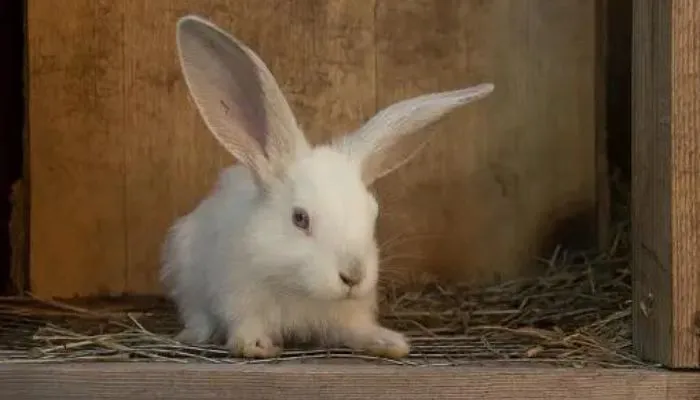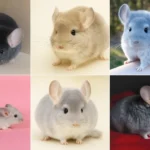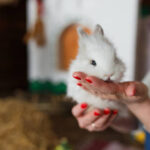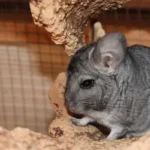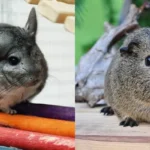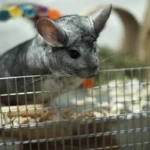An albino chinchilla is a chinchilla that lacks melanin pigmentation in its fur, eyes, and skin. Melanin is responsible for the coloration in these areas, so when it is absent, the chinchilla appears white with red or pink eyes. Albino chinchillas are born with this genetic condition, and it is inherited through their genes. Chinchillas are small rodents native to the Andes Mountains in South America. They are known for their soft and dense fur, which helps them stay warm in their high-altitude habitats. Chinchillas have become popular as pets due to their friendly nature and unique appearance. Albino chinchillas, like other chinchilla color variations, require special care. They need a dust bath to maintain their fur’s cleanliness, as chinchillas do not take traditional water baths. Additionally, they should be provided with a proper diet, consisting mainly of high-quality hay, chinchilla pellets, and fresh water.
Types of Albino Chinchillas:

Understanding the different breeds of albino chinchillas is crucial for prospective owners. While all albino chinchillas share the common trait of lacking melanin, they can belong to specific breeds that may influence their size, temperament, and overall characteristics.
- Standard Albino Chinchillas: These are the most common albino chinchillas, known for their classic white fur and pink or red eyes. They are typically friendly and make excellent pets for families.
- Mosaic Albino Chinchillas: Mosaic albino chinchillas have a unique coat pattern that sets them apart. Their fur may display a mosaic-like combination of white and another color, creating a visually striking appearance.
- Royal Persian Angora Albino Chinchillas: This breed is known for its luxurious and long fur, resembling the coat of the Persian cat. Their regal appearance makes them particularly sought after among chinchilla enthusiasts.
Each type of albino chinchilla brings its kind of magic to your chinchilla adventures. It’s like having different characters in your favorite video game – each one with its powers and special features.
Creating the Ideal Environment:
Proper care for albino chinchillas goes beyond understanding their breeds. Creating an ideal living environment is paramount for their health and well-being.
- Cage Setup: Albino chinchillas require spacious cages with multiple levels for exercise and exploration. Ensure the cage has horizontal bars for climbing, and provide platforms, hiding spots, and safe toys to keep them mentally stimulated.
- Dust Baths: Chinchillas, including albino varieties, have unique grooming needs. They don’t take water baths; instead, they require dust baths to maintain their dense fur. Provide a dust bath for your albino chinchilla regularly to keep their coat clean and healthy.
- Dietary Considerations: A proper diet is crucial for the health of albino chinchillas. High-quality hay, chinchilla pellets, and fresh water should form the basis of their diet. Avoid sugary treats, as chinchillas are prone to dental issues.
Health and Veterinary Care:
Caring for an albino chinchilla, like any other chinchilla, involves attention to their general health, diet, environment, and veterinary care. Albino chinchillas, which lack pigment in their fur and eyes, may be more sensitive to light, so providing a suitable environment is particularly important. Here are some general guidelines for the health and veterinary care of albino chinchillas:
1- Diet:
- Provide high-quality grass hay (such as timothy hay) as the primary food source. Hay helps maintain dental health and provides essential fiber.
- Offer high-quality chinchilla pellets, ensuring they contain the necessary nutrients. Avoid mixes with nuts, seeds, and dried fruits as they are high in sugar and fat.
- Use a sipper bottle to prevent contamination.
2- Environment:
- Use a spacious cage with horizontal bars for climbing. Chinchillas are highly active and need room to move.
- Provide a dust bath 2-3 times a week. Chinchillas clean their fur by rolling in dust.
3- Lighting:
Albino chinchillas may be more sensitive to bright light. Provide access to natural light but avoid direct sunlight. Ensure there are shady areas in their environment.
4- Health Monitoring:
Schedule regular veterinary checkups to monitor overall health. Chinchillas may hide signs of illness, so professional assessments are crucial. Watch for changes in behavior, appetite, and activity level.
5- Veterinary Care:
- Ensure your vet has experience with exotic pets, particularly chinchillas.
- Discuss with your vet if any vaccinations are recommended.
- Chinchillas can be susceptible to parasites; discuss preventative measures with your vet.
6- Handling:
Handle your chinchilla gently to build trust. Chinchillas are prey animals, and they may be easily stressed.
7- Teeth Care:
Provide appropriate chew toys to help maintain dental health. Chinchillas’ teeth continuously grow, and chewing helps keep them in check.
8- Hygiene:
- Keep the cage clean and free from soiled bedding to prevent respiratory issues.
- While chinchillas are generally good at grooming themselves, a gentle brushing can help remove loose fur.
9- Temperature Control:
Chinchillas are sensitive to high temperatures. Keep their environment cool, ideally between 60-70°F (15-21°C).
Interacting with Albino Chinchillas:
Interacting with albino chinchillas can be a rewarding and enjoyable experience, though it requires patience, gentleness, and an understanding of their unique needs. Albino chinchillas, with their characteristic lack of pigmentation, may be more sensitive to light, so it’s crucial to create a calm and shaded environment for them. Initially, these small rodents might exhibit shyness or skittishness, so allowing them time to acclimate to their surroundings is essential.
- Spend time near their cage, speaking softly and offering treats from your hand to build trust. When handling them, approach them with slow, deliberate movements, avoiding sudden gestures that could startle them. While some chinchillas may not enjoy being held, many appreciate gentle chin scratches or interaction at their own pace.
- Providing a safe and supervised play area outside the cage allows them to indulge their natural curiosity and exercise. It’s important to respect their vocalizations, as these can convey excitement, distress, or contentment.
- Offering a variety of safe chew toys is not only enjoyable for chinchillas but also aids in maintaining their dental health. Dust baths are a vital aspect of their care, contributing to both hygiene and entertainment.
- If you have more than one chinchilla, observe their interactions as they are social animals that may benefit from companionship. Incorporating positive reinforcement, routine, and consistency into your interactions will help foster a strong bond with these charming creatures, ultimately making the experience of caring for albino chinchillas a mutually rewarding one.
Conclusion:
In conclusion, albino chinchillas offer a unique and delightful pet-owning experience. Understanding the different breeds and providing proper care is key to ensuring their health and happiness. From creating the ideal living environment to regular veterinary care and meaningful interaction, these steps contribute to a fulfilling life for your albino chinchilla. By incorporating these care essentials into your routine, you can enjoy the companionship of these enchanting creatures for years to come.
